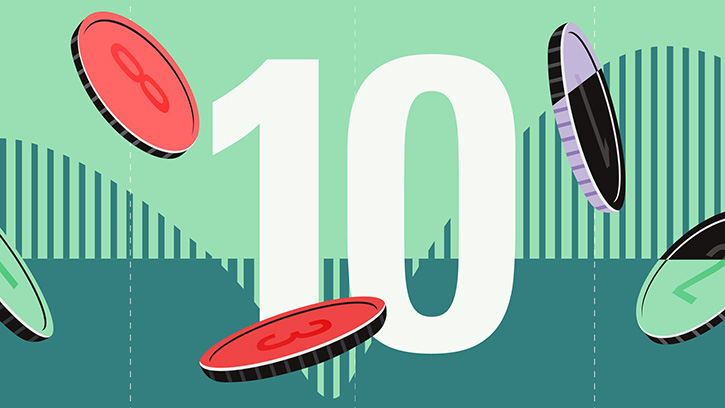Rolle im Portfolio
The UBS-ETF SMI provides exposure to Swiss large-capitalisation equities and can be used as a core holding for investors looking to build a Swiss-centric portfolio. However, investors should be aware that the SMI is very top heavy, with the five largest constituents accounting for about 70% of the index’s value. This means that price fluctuations in those shares have a substantial impact on the index’s value. Nestle, the world’s biggest food company, is the largest stock represented in the fund with a 25% weighting, followed by drug makers Novartis and Roche. Consequently, the CS ETF (CH) on SMI also has a high degree of sector concentration, with healthcare being the top sector with a 35% weighting, followed by consumer goods and financials, which combined represent another 50% of the portfolio.
This fund can also be implemented as a tactical tool to overweight Swiss equities within a diversified portfolio. It could be useful for those who want to place a bet on the near-to-medium-term prospects of the Swiss market under the belief that the benchmark index is undervalued.
For non-Swiss investors, this fund can also serve as a diversifier within a broad pan-European portfolio by providing exposure to one of the world’s most stable and strongest currencies. Over the past five years, the SMI has shown an 85% correlation to the widely-held EURO STOXX 50. By comparison, the DAX and CAC 40 have both exhibited a correlation around 98% to the EURO STOXX 50 over the same period. This lower correlation is primarily because Switzerland is not a member of the European Monetary Union. However non-Swiss investors should be mindful that a strengthening franc will enhance the return of this fund as denominated in their home currencies, but a weakening franc will weigh on its performance as measured in their home currency.
Fundamentale Analyse
Buoyant worldwide demand for Swiss exports supported Switzerland’s economy after the financial crisis, until the persistent strength of the Swiss franc became a problem. Driven by its safe haven status, the currency appreciated 20% vis-à-vis the euro--the currency of its main trading partners--and 22% versus the dollar in the first eight months of 2011. The rally prompted the Swiss National Bank (SNB) to intervene yet again last September in a bid to stabilise the franc by setting the minimum exchange rate of the euro at 1.20 francs. This shift--resulting effectively in a “peg” of the currency against the euro--has dramatically changed the role of Swiss franc-denominated assets like this fund in investors’ portfolios, which have tended to be seen as safe haven assets. That said, the pressure on the currency remains high and it is not clear whether the central bank will have the strength to sustain its action over the long term, especially if the situation in the eurozone deteriorates. Despite the “peg”, many exporters like Roche, Richemont and Swatch are still feeling the heat as they see their selling prices and profit margins squeezed by the strong franc. Looking ahead, lingering uncertainty about the resolution of the eurozone sovereign debt crisis has added to concerns over the fragile state of the global economy and will likely continue to depress consumer and business confidence and put pressure on demand for Swiss goods. That said, the SMI consists of many high-quality companies that boast sustainable competitive advantages, or wide “economic moats”, by virtue of having either exclusive patents or well-recognised brand names. These include top 10 holdings Novartis, Roche and Alcon which are able to maintain their competitive advantages with their portfolio of patented drugs and their robust R&D budgets, which support new drug discovery. However, financial groups UBS and Credit Suisse have seen their moat ratings reduced by Morningstar analysts to narrow/stable from wide in response to continued concerns about the risks the firms' investment banks pose to the core banking and asset management franchises. Nonetheless, Julius Baer has retained its wide moat.
Indexkonstruktion
The Swiss Market Index (SMI) is the benchmark index of the Swiss stock market. It is a free-float-adjusted index that comprises 20 of the largest and most liquid stocks listed on the Swiss stock exchange. The SMI represents about 85% of the total capitalisation of the Swiss equity market and its composition is examined once a year. The healthcare sector is the most heavily weighted, representing almost a third of the index's value, followed by consumer goods (30%), financials (20%) and industrials (10%). The index is very top heavy with Nestle accounting for almost 25% of the index’s value. The second and third largest stocks represented are pharmaceutical groups Novartis and Roche, which have a combined weight of over 30%.
Fondskonstruktion
The UBS ETF SMI uses full physical replication to track the performance of the SMI total return index (dividends are reinvested gross of fees). The fund holds the securities within the index. The UBS-ETF SMI may engage in securities lending, which helps to generate additional revenue. An undisclosed portion of the securities lending revenues after costs generated by UBS on behalf of the fund is passed on to the fund's shareholders. Although this activity can serve to enhance returns, it also exposes investors to counterparty risk. To protect the fund, UBS takes G10 government bonds as collateral and applies haircuts, which results in over collateralisation equivalent to 105% of the loan amount. Dividends received from the underlying stocks are invested in the index until the distribution date. This dividend treatment helps to reduce cash drag. It is worth noting that this ETF is not compliant with UCITS III and therefore is only authorised for commercial distribution in Switzerland and Liechtenstein.
Gebühren
At 0.35%, the fund’s total expense ratio (TER) is in the middle of the range for ETFs tracking the SMI.
Alternativen
There is no scarcity of options for investors looking to invest in the Swiss equity market. Providers including Credit Suisse, ComStage, iShares and db x-trackers offer their own ETFs tracking the SMI at TERs ranging from 0.25% to 0.52%. The CS ETF (CH) on SMI is the largest fund tracking the SMI traded on the Swiss exchange. It is also the most liquid as measured by its trailing 3-month average daily trading volume. As an alternative to an ETF tracking the SMI, Amundi provides a Paris-listed ETF that tracks the MSCI Switzerland, which has a TER of 0.25%. This fund, which has 36 holdings, offers very marginal exposure to the Swiss midcap market. The fund is still very top heavy with the 10 top holdings accounting for about 90% of the index. Those concerned about the high concentration risk embedded in ETFs tracking the SMI and MSCI Switzerland indices and those looking for broader market exposure could consider investing in an ETF that tracks the SLI. The Swiss Leader Index is comprised of the 30 largest and most liquid stocks on the Swiss equity market and has a capping mechanism. The weighting of the four largest constituents is limited to 9% and the weighting of all other stocks to 4.5%. As a result, the SLI has higher allocations to the industrials and basic materials sectors. The SLI outperformed the SMI by 8% in 2009 and 4.6% in 2010, albeit with a higher level of volatility. UBS, Credit Suisse and db x-trackers offer ETFs tracking the SLI, sporting TERs between 0.35% and 0.40%.
Die in diesem Artikel enthaltenen Informationen dienen ausschließlich zu Bildungs- und Informationszwecken. Sie sind weder als Aufforderung noch als Anreiz zum Kauf oder Verkauf eines Wertpapiers oder Finanzinstruments zu verstehen. Die in diesem Artikel enthaltenen Informationen sollten nicht als alleinige Quelle für Anlageentscheidungen verwendet werden.

















